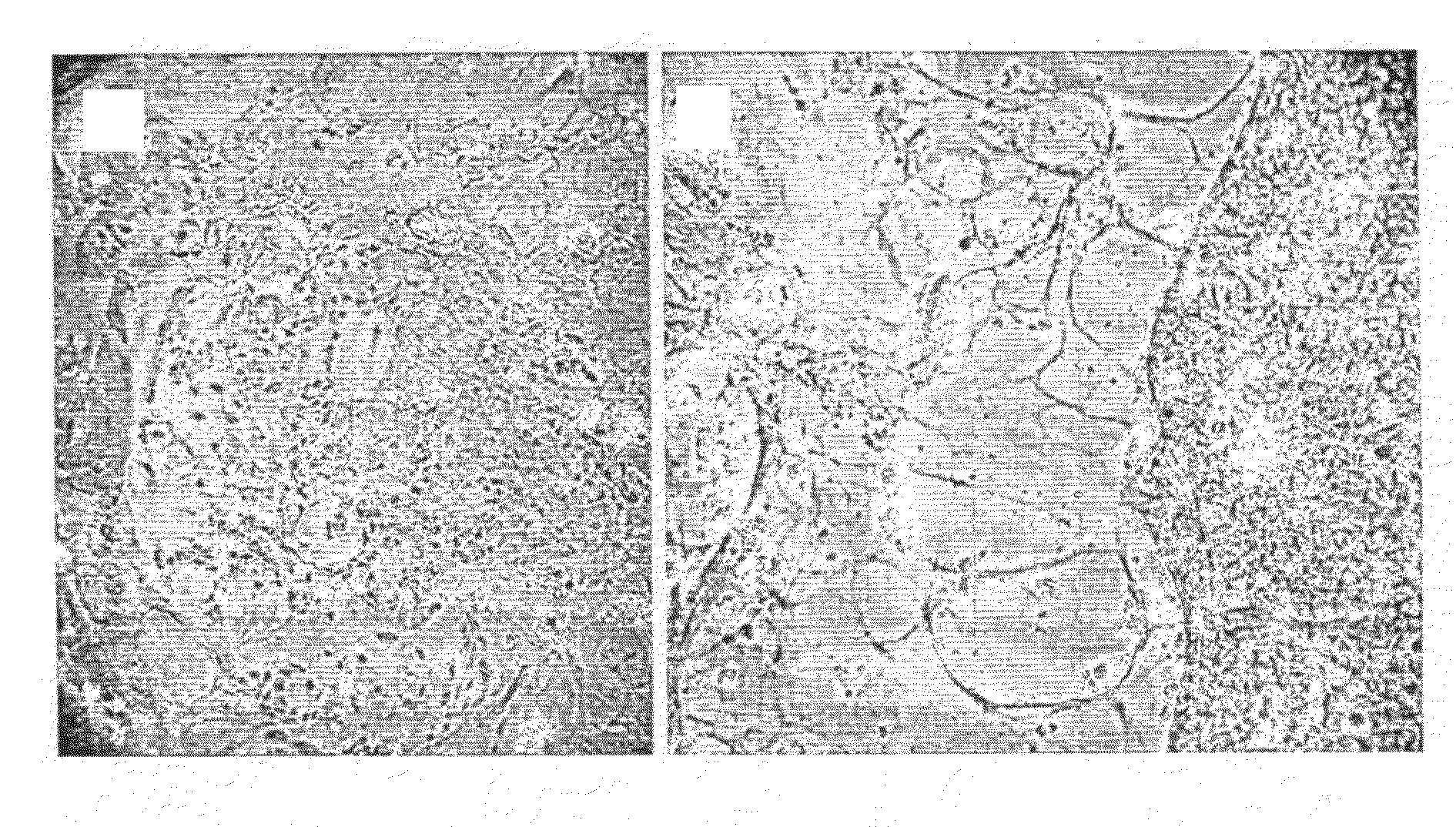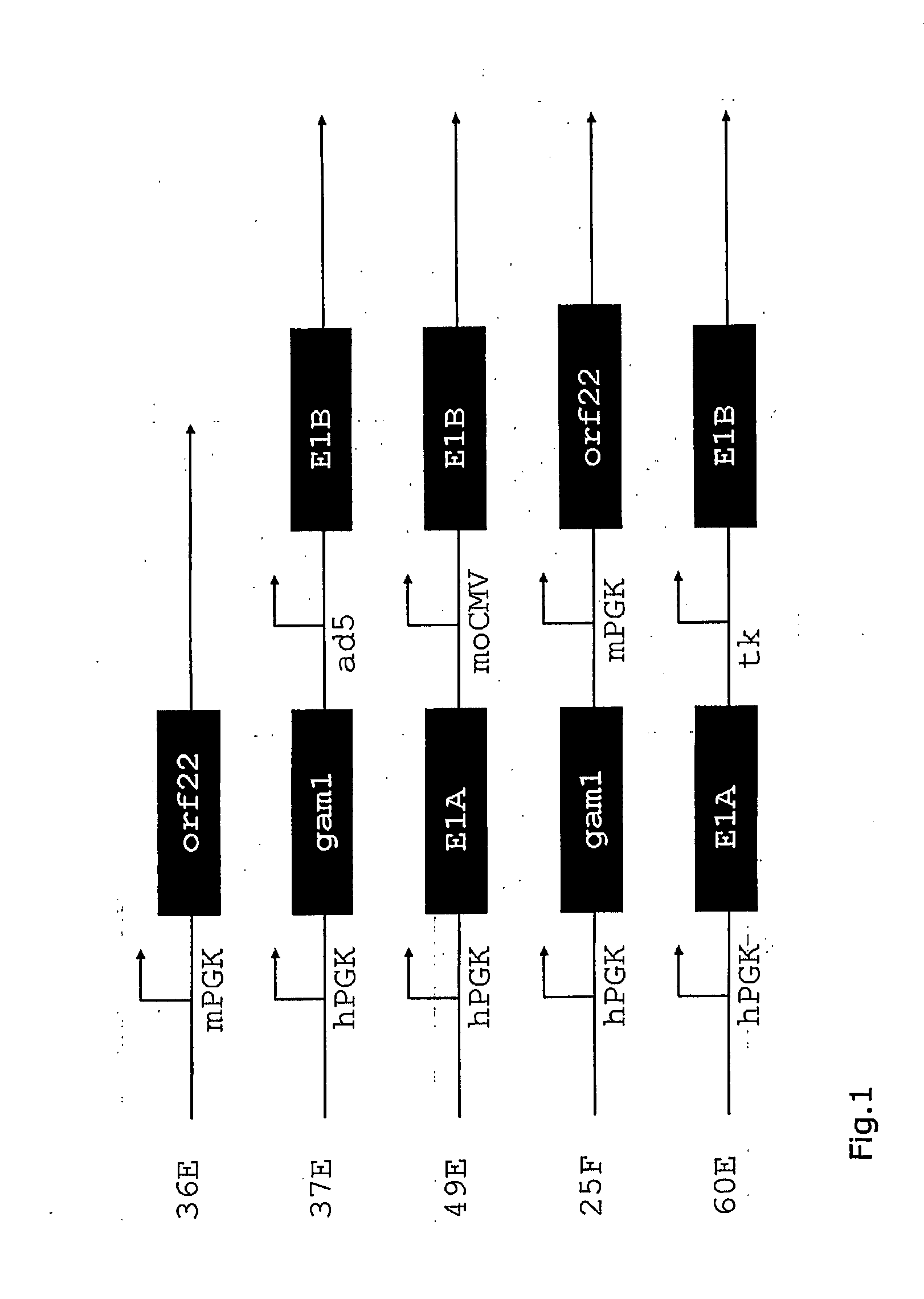Immortalized Avian Cell Lines For Virus Production
a technology of immortalized avian cells and virus, which is applied in the field of immortalized avian cell lines for virus production, can solve the problems of increasing difficult to maintain spf flocks completely free of pathogens, and high so as to reduce the risk of joining transfer, reduce the cost of vaccine preparation, and facilitate the effect of growth
- Summary
- Abstract
- Description
- Claims
- Application Information
AI Technical Summary
Benefits of technology
Problems solved by technology
Method used
Image
Examples
example 1
Immortalization of primary Duck Cells with Adenovirus 5 E1A,B
[0103]The adenovirus sequences for E1A and E1B were amplified from the culture of passage 8 of the first generation (E1 deleted) adenovirus Admuc grown in HEK 293 which was heavily contaminated with wild type virus using provestart polymerase (Qiagen).
[0104]The following primers were used:
VS182ACTCGAGCTGACGTGTAGTGTATT(SEQ ID NO:1)VS183CACACGCAATCACAGGTT(SEQ ID NO:2)
to amplify the E1 A region and
VS184ACTCGAGTCATGGAGGCTTGGGAGT(SEQ ID NO:3)VS185ACACATTTCAGTACCTCA(SEQ ID NO:4)
to amplify the E1 B region. Both fragments were first cloned into pPCR4blunttopo (Invitrogene).
[0105]The E1B construct misses the splice acceptor from the E1B message. It was therefore replaced by a synthetic one amplified using primers from the leader intron of a human immunoglobulin heavy chain. As template, the genomic DNA from PBG04 (DMSZ ACC2577), a murine-human heterohybridoma was used.
[0106]Primers:
VintSA-FAAGGTACCCTCCCTAGTCCCAGTGA(SEQ ID NO:5)Vint...
example 2
Improved Preparation of Immortalized Avian Cell Lines
a) Preparation of Primary Cells
[0114]The flock of origin for the duck eggs was certified to be free of Salmonella enteritidis and S. typhimurium; Mycoplasma gallisepticum and M. synoviae; cases of leucosis, reticulo-endotheliosis, psittacosis, avian influenza, duck hepatitis, and Derzsy's disease. The animals intentionally were not vaccinated against parvovirus and no cases of parvovirosis were detected. Animals in the flock of origin have been vaccinated against S. enteritidis and S. typhimurium; Pasteurella multicodica; the metapneumovirus Turkey rhinotracheitis; and the paramyxovirus causing Newcastle disease.
[0115]The eggs were allowed to equilibrate without agitation at room temperature and after two days were incubated at 38° C. in a damp chamber, rotated frequently by alternating +45° and −45°.
[0116]Duck embryos were sacrificed for isolation of primary cells after one or three weeks of incubation. Eggs were transferred to a...
example 3
Immunofluorescence Assay for Stable Transfection
[0136]Cultures of potentially immortalized cells were seeded on glass slides and allowed to proliferate for several days before fixation with ice-cold methanol for 10 min. The fixed cells were incubated with antibodies against E1A and E1B 55K proteins, secondary antibodies, and fluorescent dye specific against the latter according to standard immunofluorescene methods (Becton Dickinson, UK, #554155 antibody against E1A, diluted 1:30; Oncogene, USA, #DP08-100UG antibody against E1B 55K, diluted 1:30; secondary antibody directed against mouse or rat, respectively, and conjugated to biotin, both from Jackson Immuno Research, USA, diluted 1:80; visualization with Jackson Immuno Research, USA, #016-070-084 streptavidin-Texas Red conjugate, diluted 1:100). Primary cells still abundant in early, not yet fully established immortalized cell lines and readily distinguishable by morphology provided a convenient internal negative control for antib...
PUM
| Property | Measurement | Unit |
|---|---|---|
| Time | aaaaa | aaaaa |
| Stability | aaaaa | aaaaa |
Abstract
Description
Claims
Application Information
 Login to View More
Login to View More - R&D
- Intellectual Property
- Life Sciences
- Materials
- Tech Scout
- Unparalleled Data Quality
- Higher Quality Content
- 60% Fewer Hallucinations
Browse by: Latest US Patents, China's latest patents, Technical Efficacy Thesaurus, Application Domain, Technology Topic, Popular Technical Reports.
© 2025 PatSnap. All rights reserved.Legal|Privacy policy|Modern Slavery Act Transparency Statement|Sitemap|About US| Contact US: help@patsnap.com



